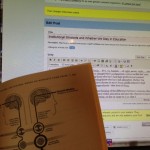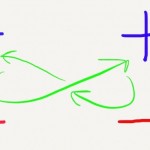I’m facing a conundrum. This summer I read Mathematical Mindsets: Unleashing Students’ Potential Through Creative Math, Inspiring Messages and Innovative Teaching by Jo Boaler (with a foreword by Carol Dweck of Mindset fame). I was completely fired up by Boaler’s message about how keeping students frustrated is the key to keeping them learning; because, if they’re not frustrated, their prior knowledge suffices for your assignment.
I also decided to use her keys to engagement to design the lessons I would give my eighth graders taking high school credit algebra. Engaging lessons, Boaler says:
- Are open to multiple pathways, representations, and methods
- Include inquiry
- Put the problem before the method
- Contain a visual component to “see” the math
- Have a low floor and high ceiling
- Ask students to reason, convince, and be skeptical
The first lesson of the year was to find ways to save 20 periods worth of class time by defining class practices that would save a minute or two each day. First, they had to figure out how many periods a minute’s savings every day added up to after 180 days. Next, they had to use that result to figure out how many minutes per day we had to save every day to add up to 20 days over the course of the year. Finally, they had to write a up a workable plan based on their results.
The next lesson was simpler. Students had to figure out all the ways to arrange tables with different seating capacities in a ballroom for different events while keeping within the room’s occupancy limit.
Then the class spent a couple of weeks predicting the next shape in a sequence of lines, squares, and blocks and discovering how linear, quadratic, and cubic functions could be useful tools in doing such work. (Those problems were based directly on Boaler’s book.)
Every problem above took several days, but I’ve never seen such engagement. I’ll immodestly say that the problems hit all of Boaler’s features of engaging lessons. Furthermore, I loved being able to tell them their frustration meant they were having to learn new ways of thinking and that that was what we were after.
But by then we were halfway through the quarter, and I realized we were way behind on material that will be assessed in November. So, I started teaching the usual algebra stuff. You remember, all those properties, how to solve equations, and so forth. Class engagement dropped off significantly.
Plus, there were homework assignments that only half the class would even attempt. It wasn’t like they were trying and giving up. They weren’t even starting the work. And that’s something I’ve never seen in eighth graders taking high school algebra.
So, I tracked down their test scores from last year and discovered that about half the 31 students were probably misplaced, having scored only “partially proficient” in seventh grade math.
And that brings us to the conundrum. I could keep pushing them with the kinds of problems we’ve done so far: Problems that are heavy on logic, push their thinking, and push their perseverance. But these problems mostly demand only basic arithmetic to solve for the answer once the analysis is complete.
That approach would guarantee active participation, but I couldn’t really justify giving high school credit for algebra. Too much content would be left out leaving them unprepared for geometry or algebra 2.
So, I talked to a group of students about moving into regular eighth grade math when the second quarter starts. Most expressed relief. Two said that’s what they had hoped for. One said, no, she wanted keep trying the algebra. God bless her.
But I wonder, what if I had never looked at their test scores? What if I had practiced what I preached? What if I had decided that my frustration meant that I had find new ways of thinking about teaching and learning? What if I had pushed myself to find the kind of problems that kept them involved but also introduced the tools of algebra instead of applying the tools of arithmetic?
That will be the challenge going forward with the students that remain. I know there are plenty of good resources out there – like Boeler’s You Cubed website – that will help.
But I can’t say it doesn’t burn to know I poisoned my thinking about these children by seeing them as test scores instead of students.
_________________________
A final note – to wrap up the quarter I hit them will one last killer problem. The kids claimed they hated it, but for the first time in weeks kids have RUN across the classroom to check their methods with me. They’ve jumped up and down when they’ve been right, or asked, with undivided attention, what to do next.
Here’s the problem. Why not give it a go?
On January 1, I begin a routine that I’ve continued every single day this year – without a single miss:
- Every morning I stop at a convenience store and get a healthy snack that cost $1.69. I pay with two $1 bills and put the change in the tray by the gearshift.
- When there is enough change in the tray to buy the snack, I pay with that and put the change in a little pouch I keep in the glove compartment.
- When there is enough change in the pouch, I pay with that and leave the change on the counter.
- After my trip this morning, October 3, how much money do I have in the tray and the pouch?
- After my trip on December 31, how much money will I have in the tray and the pouch?
I can’t wait to see your answers.









Comments 3
Hey– I just came across this blog entry on Twitter: http://thequietdisruptor.com/2016/10/the-path-of-resistance/ I think your dilemma is real simply because of the discrete Algebra skills the students will need to move forward in the course sequence. That is a tough one. I like the math problem you pose at the end. At our school there is a Math Skillbuilders class for the 7th and 8th graders who are struggling with math. I wonder with scaffolding if that type of thinking would get them motivated and moving forward. At any rate, I would want to be in your class.
Well, for risk of embarrassing myself, I am going to abstain from solving the math problem. This is a great post and really challenges us to think as educators. I find it so intriguing that you used the word “frustrated”. I think the fact that you challenged them and it motivated them is fantastic. This also brings up a discussion that I have had with several peers over the last couple of years, to check the prior years test scores/file before students arrive, or wait until a couple of weeks in?.?.? We need to know who are students are and understand how to reach them as soon as possible, but does it mess with our judgement when we see data before getting to know our students. This is an ethical debate that many educators wrestle with and I am so glad you decided to talk about how to walk the line between motivation and too much too soon. Thank you for providing the links as well so that I can do some more investigating.
This is a great post and really challenges us to think as educators. I find it so intriguing that you used the word “frustrated”. I think the fact that you challenged them and it motivated them is fantastic. This also brings up a discussion that I have had with several peers over the last couple of years, to check the prior years test scores/file before students arrive, or wait until a couple of weeks in?.?.? We need to know who are students are and understand how to reach them as soon as possible, but does it mess with our judgement when we see data before getting to know our students. This is an ethical debate that many educators wrestle with and I am so glad you decided to talk about how to walk the line between motivation and too much too soon. Thank you for providing the links as well so that I can do some more investigating.
HI Sandy- first of all, GREAT way to get your kiddos Critically Thinking! My vote would be to continue to push their limits with problem that’s are multi-layered, thought provoking, and ENGAGING! For the past two years I had a co-teaching model with 4th and 5th graders. All of the identified SLD students were a part of my Gen Ed class. I taught math with Boaler’s mindset and methods. I saw so much growth in ALL my students by creating that organized chaos within our math lessons. Many of my students who did not like math…now love it. Many of the students that were partially proficient coming into my class…became proficient and above based on their AzMERIT scores. But honestly, their confidence grew and their application and critically thinking skills…carried over to so much more! Hopefully my students will have a WONDERFUL teacher like you when they get into middle school. Thank you!